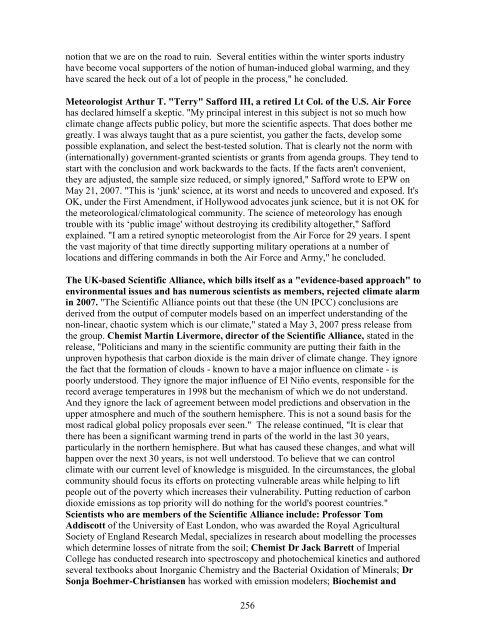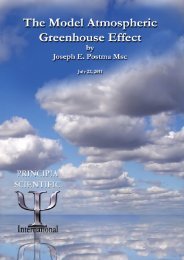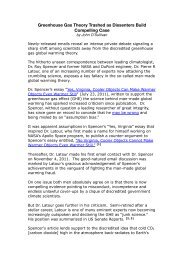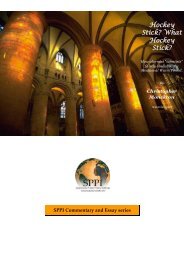Than 1000 International Scientists Dissent Over Man-Made Global ...
Than 1000 International Scientists Dissent Over Man-Made Global ...
Than 1000 International Scientists Dissent Over Man-Made Global ...
Create successful ePaper yourself
Turn your PDF publications into a flip-book with our unique Google optimized e-Paper software.
notion that we are on the road to ruin. Several entities within the winter sports industry<br />
have become vocal supporters of the notion of human-induced global warming, and they<br />
have scared the heck out of a lot of people in the process," he concluded.<br />
Meteorologist Arthur T. "Terry" Safford III, a retired Lt Col. of the U.S. Air Force<br />
has declared himself a skeptic. "My principal interest in this subject is not so much how<br />
climate change affects public policy, but more the scientific aspects. That does bother me<br />
greatly. I was always taught that as a pure scientist, you gather the facts, develop some<br />
possible explanation, and select the best-tested solution. That is clearly not the norm with<br />
(internationally) government-granted scientists or grants from agenda groups. They tend to<br />
start with the conclusion and work backwards to the facts. If the facts aren't convenient,<br />
they are adjusted, the sample size reduced, or simply ignored," Safford wrote to EPW on<br />
May 21, 2007. "This is ‗junk' science, at its worst and needs to uncovered and exposed. It's<br />
OK, under the First Amendment, if Hollywood advocates junk science, but it is not OK for<br />
the meteorological/climatological community. The science of meteorology has enough<br />
trouble with its ‗public image' without destroying its credibility altogether," Safford<br />
explained. "I am a retired synoptic meteorologist from the Air Force for 29 years. I spent<br />
the vast majority of that time directly supporting military operations at a number of<br />
locations and differing commands in both the Air Force and Army," he concluded.<br />
The UK-based Scientific Alliance, which bills itself as a "evidence-based approach" to<br />
environmental issues and has numerous scientists as members, rejected climate alarm<br />
in 2007. "The Scientific Alliance points out that these (the UN IPCC) conclusions are<br />
derived from the output of computer models based on an imperfect understanding of the<br />
non-linear, chaotic system which is our climate," stated a May 3, 2007 press release from<br />
the group. Chemist Martin Livermore, director of the Scientific Alliance, stated in the<br />
release, "Politicians and many in the scientific community are putting their faith in the<br />
unproven hypothesis that carbon dioxide is the main driver of climate change. They ignore<br />
the fact that the formation of clouds - known to have a major influence on climate - is<br />
poorly understood. They ignore the major influence of El Niño events, responsible for the<br />
record average temperatures in 1998 but the mechanism of which we do not understand.<br />
And they ignore the lack of agreement between model predictions and observation in the<br />
upper atmosphere and much of the southern hemisphere. This is not a sound basis for the<br />
most radical global policy proposals ever seen." The release continued, "It is clear that<br />
there has been a significant warming trend in parts of the world in the last 30 years,<br />
particularly in the northern hemisphere. But what has caused these changes, and what will<br />
happen over the next 30 years, is not well understood. To believe that we can control<br />
climate with our current level of knowledge is misguided. In the circumstances, the global<br />
community should focus its efforts on protecting vulnerable areas while helping to lift<br />
people out of the poverty which increases their vulnerability. Putting reduction of carbon<br />
dioxide emissions as top priority will do nothing for the world's poorest countries."<br />
<strong>Scientists</strong> who are members of the Scientific Alliance include: Professor Tom<br />
Addiscott of the University of East London, who was awarded the Royal Agricultural<br />
Society of England Research Medal, specializes in research about modelling the processes<br />
which determine losses of nitrate from the soil; Chemist Dr Jack Barrett of Imperial<br />
College has conducted research into spectroscopy and photochemical kinetics and authored<br />
several textbooks about Inorganic Chemistry and the Bacterial Oxidation of Minerals; Dr<br />
Sonja Boehmer-Christiansen has worked with emission modelers; Biochemist and<br />
256





